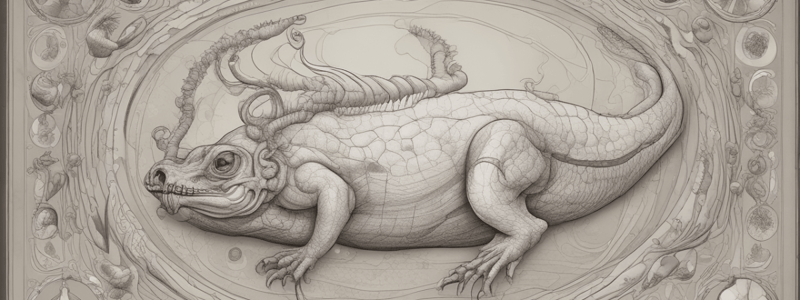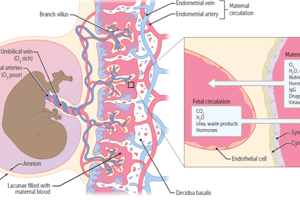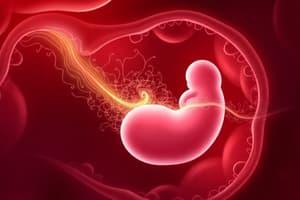Podcast
Questions and Answers
What is the characteristic feature of Freemartins?
What is the characteristic feature of Freemartins?
- They are male calves with underdeveloped testes
- They are twin calves with normal reproductive organs
- They are fertile female calves
- They are sterile female calves with underdeveloped ovaries (correct)
What is the recommended estrus detection rate in bovine reproductive management?
What is the recommended estrus detection rate in bovine reproductive management?
- Around 90-100%
- Around 70-80%
- Around 50-65% (correct)
- Around 30-40%
What is the ideal calving interval in bovine reproductive management?
What is the ideal calving interval in bovine reproductive management?
- Around 15 months
- Around 14 months
- Around 12 months
- Around 13 months (correct)
How many cows should be in estrus on any given day in a pen with 120 non-pregnant cows?
How many cows should be in estrus on any given day in a pen with 120 non-pregnant cows?
What is the recommended average days open for pregnant cows in bovine reproductive management?
What is the recommended average days open for pregnant cows in bovine reproductive management?
In which part of the female reproductive system do ova get fertilized in mammals?
In which part of the female reproductive system do ova get fertilized in mammals?
Which type of placentation do primates, humans, and rabbits have?
Which type of placentation do primates, humans, and rabbits have?
At what stage of estrus do Basenji dogs typically give birth?
At what stage of estrus do Basenji dogs typically give birth?
How can you predict impending parturition in dogs?
How can you predict impending parturition in dogs?
How long after breeding does estrus behavior last in cows?
How long after breeding does estrus behavior last in cows?
At what stage of pregnancy can placentomes be felt in cows?
At what stage of pregnancy can placentomes be felt in cows?
How long after breeding can abdominal palpation reliably detect pregnancy in dogs?
How long after breeding can abdominal palpation reliably detect pregnancy in dogs?
How often does the estrus cycle recur in felines?
How often does the estrus cycle recur in felines?
Flashcards are hidden until you start studying
Study Notes
Mammalian Reproduction
- Ova in mammals are fertilized in the oviduct, also known as Fallopian Tubes.
Cotyledonary Placentas
- Cotyledons are the fetal side, and caruncles are the maternal side.
- Together, they form the placentome.
Placentation in Specific Animals
- Primates, humans, and rabbits have a hemochorial and discoid placentation.
Canine Reproduction
- Increase in estrogens speeds up turnover of vaginal epithelial cells, causing progressive cornification.
- Cell color changes:
- Anestrus and proestrus: pink-purple
- Estrus and diestrus: blue-purple
- Parturition occurs 58-72 days after breeding at an unknown stage of estrus.
- Basenji: one estrous cycle per year.
- Diagnosis methods:
- Radiographs: count litter size after 45 days
- Abdominal palpation: detect pregnancy at about 21 days
- Impending parturition can be predicted by a transient temperature drop in the bitch.
- LH surge peaks at behavioral estrus and acceptance of male, ovulation occurs 2 days later.
Feline Reproduction
- Birth occurs 64-69 days from breeding at an unknown state of estrus or 63 days from breeding at ovulation.
- Diagnosis methods:
- Abdominal palpation: reliably detects pregnancy at about 21 days
- Ultrasound: detects fetal heartbeat at 28 days
- Radiographs: count litter size after 40 days
- Obvious mammary development can be seen in the final 2 weeks.
- Estrus cycle recurs every 2-3 weeks (interestrus interval).
Bovine Reproduction
- Estrus behavior lasts 18 hours.
- Signs of estrus:
- Standing to be mounted
- Riding other cows
- Restlessness
- Bellowing
- Ruffled hair or hair loss on tail head
- Clear vaginal mucus discharge appears after estrus.
- During diestrus, a cow has a soft corpus luteum.
- Diagnosis methods:
- Placentomes can be felt at 70-75 days
- Membrane slip can be felt at 30-35 days
- Fremitus can be felt at 90-120 days
- Freemartins:
- Sterile female calves born twin to a male
- Underdeveloped ovaries due to XY antigens crossing the chorionic placenta blood vessels
- Characterized by a short vagina and no cervix
Bovine Reproductive Management
- Estrus detection rates: approximately 50-65%.
- Calving interval: around 13 months.
- First service conception rate: 40% or greater.
- Average days open: around 115 days, ideally in the low 100s.
- Services per conception:
- Pregnant cows: less than 2.5
- All cows serviced: less than 3.5
- Number of cows in estrus on a given day:
- Divide the number of non-pregnant cows by 18 and then by 21.
Studying That Suits You
Use AI to generate personalized quizzes and flashcards to suit your learning preferences.




